Before the arrival of European settlers, the Red River Valley in south-central Manitoba
was a vast sea of tall-grass prairie, a complex ecosystem with an
astonishing variety of grasses, flowers and wildlife. Dominated
by grasses that reached over two metres in height, this was the
most productive type of prairie in North America. The very richness
of the tall-grass prairie, however, spelled its doom. With deep
fertile soils the colour of coal, the prairie was soon transformed
by settlers. Cereal and forage crops are now cultivated where orchids,
lilies, and grasses once thrived. Tall-grass prairie in Manitoba
is only a fraction (less than 1%) of its former 6,000 square kilometres. |
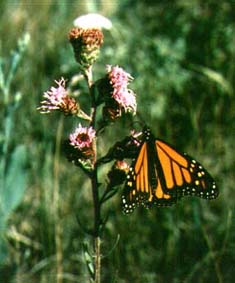
|
|
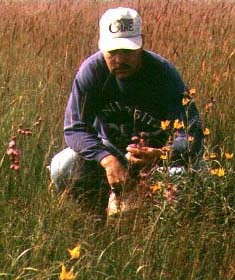
|
In
1987, the Manitoba Naturalists Society launched a systematic
survey to locate the surviving remnants of this beautiful
landscape. Only a few sites were discovered and many were
less than a hectare in size. The largest tracts of tall-grass
prairie were found near the towns of Tolstoi and Gardenton
in southeastern Manitoba. In 1989, the Critical Wildlife Habitat
Program, a cooperative program involving seven conservation
organizations, began securing lands in the Tolstoi-Gardenton
area for a prairie preserve. Today, over 2000 hectares of
tall-grass prairie are protected within this Preserve. |
| |
|
Like many remnant
grasslands, the lands within Manitoba's Tall-grass Prairie
Preserve escaped destruction because the land was too difficult
to plough. Large boulders, aspen groves and far-reaching swamps
discouraged the early settlers in turning the precious sod,
allowing this unique plant and animal system to endure. Today,
the area is home to over 200 plant species, from flowers and
grasses to shrubs and trees, and a variety of animals from
butterflies, frogs and songbirds to voles, deer, moose and
an occasional bear.
|
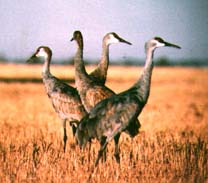
|
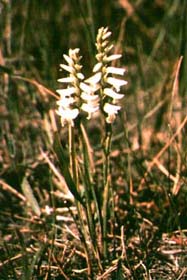
|
From April's first
growth to October's killing frost, the Tall-grass Prairie
Preserve is in constant metamorphosis, its colour, contour
and fragrance changing from week to week. In early spring,
the flowers of yellow star-grass and early blue violets appear,
followed by flowers in every imaginable shade and colour.
The blossoms of golden alexander, prairie smoke, blue-eyed
grass and seneca root soon carpet the landscape. In May, the
flowers of the endangered small white lady's slipper appear
briefly and then all but disappear as other plants follow
in a succession of colour. |
Birds
of many kinds fly and soar above the preserve. Over 90 species
of birds nest in the nooks and crannies of the Preserve. The
trumpeting call of a nesting sandhill crane can be heard from
a distance while the soft tapping of the yellow rail eludes
all but the keenest listeners. |
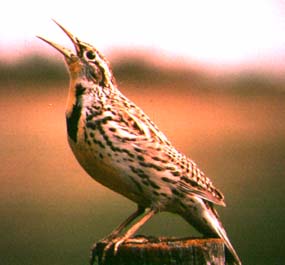
|
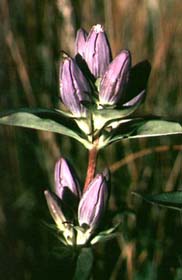
|
In July, the rare and enchanting western prairie fringed orchid blooms. Purple
and white prairie clover lend contrasting colours to the prairie
while enriching the soil with nitrogen. The composites begin
their showy displays from black-eyed susans to blazing stars
and the early goldenrods. The sight of the native prairie
at the height of the blooming season is a never-to-be forgotten
experience. This is when the greatest diversity of butterflies
can be sighted -- 20 or more kinds on a good day -- including
the rare Poweshiek skipper, a species found only in the Preserve
area within Canada. |
In
August, the prairie is aglow with expanses of golden Indian
grass, prairie cord grass, prairie dropseed and big bluestem.
Hidden among the grasses are rare orchids: nodding ladies
tresses bloom in early August while Great Plains ladies tresses
flower a few weeks later. The blossoming of the gentians herald
the start of autumn; the flowering of the closed gentian is
one of the last colourful events on the prairie, often blooming
until the harshest frosts. Soon the monarch butterflies will
begin their fall migration to the southern United States and
Mexico as yet another prairie season passes.
|
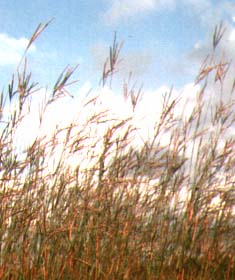 |
Endangered Species
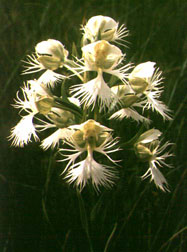 |
Since the tall-grass
prairie is an endangered ecosystem, some of the associated
plants and animals are also scarce.
The western prairie fringed
orchid (Platanthera praeclara) is an endangered orchid
found in the north block of the Prairie Preserve. It grows
in remnant native prairies and wet meadows in the United States
and Canada. It is estimated that there are fewer than 10,000
plants in the Preserve, the only Canadian location of this
plant. The western prairie fringed orchid is a sturdy, long-lived
perennial with creamy-white to white flowers in a cluster
25 centimetres or more in diameter. The lower petal of each
flower is delicately fringed. Blooming generally begins in
early-July and lasts for three weeks. It is believed that
sphinx moths play an important role in pollinating the orchids.
These orchids require a companion fungus, known as mycorrhizae,
to survive; this fungus is easily destroyed when the plant
is dug up. |
The small
white lady's slipper (Cypripedium candidum) is an
endangered orchid found in the wet meadows of the south
block of the Prairie Preserve. Small white lady's slippers
grow in clumps, blooming briefly in May and then all but
disappearing. The small white lady's slipper cannot reproduce
without the presence of a companion fungus, nor can the
mature plants live without a symbiotic fungus found within
its root system.
Protected under Manitoba's Endangered Species Act, it is unlawful to pick, dig or disturb
the surroundings of the small white lady's slippers or the
western prairie fringed orchid. The Preserve was established
to protect and conserve the native species found there,
so please do not pick, dig or collect any of the plants
and animals. |
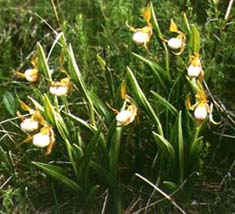 |
Management
Protection
alone is not enough to keep a prairie healthy. Idle or poorly
managed grasslands are often invaded by native trees and
shrubs or exotic weeds. Even some native grasses, when heavily
grazed or left idle, can increase to the point where they
crowd out desirable species and reduce the diversity of
the community. Historically grasslands were shaped by fire,
drought and grazing by mammals and insects with seasonal
periods of rest. Before settlers cleared the fields and
ploughed firebreaks, the red buffalo, as the Plains Indians
called wildfires, would rage from horizon to horizon. For
tall-grass prairie, these fires were far from a destructive
force, but rather an important part of prairie ecology.
Fire broke down dead and decaying vegetation, returning
nutrients to the soil and giving the sun an opportunity
to warm the ground in early spring. The growth of trees
and shrubs, which invade the prairie, was slowed by fire.
Prairie plants, with much of their energy stored in underground
root systems, were better adapted to fire than the shrubby
invaders with their energy stored in above-ground parts. |
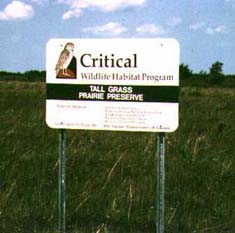
|
When
the prairies were in their prime, rotational grazing occurred
naturally without any help from humans. A herd of bison
or elk would graze an area clean and then move on to greener
pastures. This continual movement provided native grasslands
with fertilizer, a method of seed dispersal and seasonal
periods of rest to recover and replenish their food supplies.
Because people have altered the prairie ecosystem so dramatically it is impossible to
mimic the natural forces exactly. Today, management of tall-grass
prairie requires the use of techniques that duplicate wildfires
and grazing by wild animals. Prescribed burning, approximately
once every three years, is necessary to keep the prairie
healthy. To be effective and safe, managed burns need to
be carefully planned and conducted under controlled conditions.
Rotational grazing by native or domestic grazers can also
be vital to the health of native prairies. A planned, properly
managed grazing system with periods of rest can help increase
the numbers of native grass species in a tall-grass prairie.
Grazing can be imitated by mowing and haying, which if properly
timed can encourage or discourage particular plant species.
Exotic or woody species must often be hand-cleared or removed
by other techniques, such as bio-control (the use of natural
enemies to control non-native plants) or girdling (the removal
of a layer of bark on a tree to kill the tree and prevent
suckering). A combination of these activities are being
used to manage Manitoba's Tall-grass Prairie Preserve. |
|
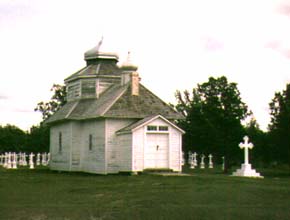
|
Most
lands acquired for the preserve are accessible year round
for hiking and walking. Vehicle access and some other activities
may be limited. On-site signage will provide furtherer detail.
Additional Tall-grass prairie in the are has been conserved
by the Critical Wildlife Habitat Program through lease arrangements
with private landowners. Visitors must have permission from
the landowner before entering private lands. Please contact
the Critical Wildlife Habitat Program for more information. |
Plant
and animal lists (including butterflies) are available on
request from the Critical Wildlife Habitat Program.
Much of the land in the Tall-grass
Prairie Perserve was originally settled by the pioneers from
Bukovinia in the western Ukraine. The first Bukovans arrived
in Canada in 1896 and soon after settled in the Stuartburn
Gardenton area. Although the soil in this area of Manitoba
was not aile as sites farther west in the Red River Valley,
each section contained many wooded acres, a sourc of fuel
and lumber. In many cases, stones and wetlands made cultivation
of the land impossible. |
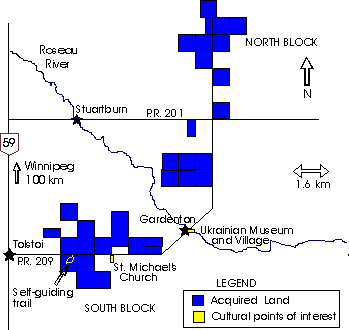
|
Although life for
these settlers was demanding, a strong social and religious
life developed. By 1900 several churches had been constructed
in the area. The most notable was St. Michael's, the first
permanent Ukrainian Greek Orthodox church built in Canada.
This structure, in continual use since its consecration, stands
as a symbol of the Ukrainian immigrants' faith and determination
to preserve their religion in a new land. Original homesteads,
typifying the materials and construction used by the earles,
are found through out the area. Artifacts from this settlement
can be seen in the Gardenton Ukrainian Museum and Tolstoi. Washroom facilities are also
available at the Gardenton Museum. |
Things to do on the Preserve
Most of lands in the Preserve
are open year round for hiking, bird watching and photography.
An 1.5 km interpretive trail, developed by the local community,
guides visitors through part of the Preserve. This trail is
located 2.5 km east of Tolstoi on Provincial Road 209.
An annual Prairie Day, held
the second Saturday in August, highlights the flora and fauna
of the Preserve. A traditional Ukrainian meal and entertainment
is a great way to end this action-packed day.
While you are in the area, a
trip to St. Michael's church, the first permanent Ukrainian
Greek Orthodox church built in Canada, might be in order.
This structure, in continual use since its consecration, stands
as a symbol of the Ukrainian immigrants' faith and determination
to preserve their religion in a new land. Artifacts from the
early Ukrainian settlements can be seen at the Gardenton Ukrainian
Museum in nearby Gardenton.
NatureNorth.com would like to thank the Critical Wildlife Habitat Program and the Wildlife Branch, Manitoba Natural Resources for permission to reproduce this "Manitoba's Tall-grass Prairie Preserve" brochure.
For more information please
contact:
|
|
Thanks for learning about Manitoba's Tall Grass Prairie Preserve! Bye for now!
|
|













